Ten more bluebirds fledged in August. The season is now over and all the boxes have been removed for cleaning and winter storage. A total of 53 birds fledged from the trail this year: 33 bluebirds, 11 chickadees, and 9 tree swallows.
Follow the natural resources team as we restore Saint Paul's natural areas with the help of generous grants, project partners, and volunteers.
Wednesday, August 30, 2017
Como Park Bluebird Trail Update: August 28, 2017
Post contributed by Sharon, volunteer bluebird trail monitor:
Ten more bluebirds fledged in August. The season is now over and all the boxes have been removed for cleaning and winter storage. A total of 53 birds fledged from the trail this year: 33 bluebirds, 11 chickadees, and 9 tree swallows.
Ten more bluebirds fledged in August. The season is now over and all the boxes have been removed for cleaning and winter storage. A total of 53 birds fledged from the trail this year: 33 bluebirds, 11 chickadees, and 9 tree swallows.
Thursday, July 27, 2017
Como Park Bluebird Trail Update: July 27, 2017
Post contributed by Sharon, volunteer bluebird trail monitor:
In the past two weeks, 4 bluebirds and 7 tree swallows fledged. Eight nest boxes are now empty as the
nesting season winds down. There are 12 bluebirds in the
remaining three occupied boxes, 8 likely to fledge soon. Vandalism is
unfortunately a recurring problem on the trail—two weeks ago a pinecone put
into a box prevented bluebirds from laying eggs. Those bluebirds moved to
another box, built another nest, and laid 5 eggs, only to have another pinecone
put into their box—this time two eggs were destroyed, the rest could not be
incubated, and the pair gave up for the season. A predator guard in the same
area of the trail was also broken.
In the past two weeks, 4 bluebirds and 7 tree swallows fledged. Eight nest boxes are now empty as the
 |
| Damaged bluebird eggs |
 |
| The last four bluebirds of the season |
Friday, July 14, 2017
Como Park Bluebird Trail Update: July 12, 2017
Post contributed by Sharon, volunteer bluebird trail monitor:
 |
| Male bluebird on a sultry morning in the park |
 |
| Newly hatched bluebirds |
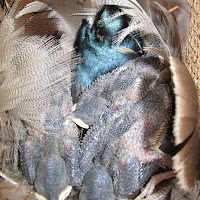 |
| Female with her week old tree swallows in the nest |
Wednesday, July 5, 2017
Como Park Bluebird Trail Update: June 26, 2017
Post contributed by Sharon, volunteer bluebird trail monitor:
A tree swallow nest with at least four week-old chicks in it failed—the chicks were dead and covered with flies. It may be that this pair of tree swallows began another nest right away on top of an old bluebird nest in another nearby box—the new tree swallow nest has four eggs in it. Another two boxes have at least 5 tree swallows at various stages of development.
 |
| Three bluebird eggs from round 2 of nesting. |
There are 6 healthy chickadees approaching two weeks old in another box. Two weeks ago mom was on that nest, and a week ago, she was also on the nest along with her nearly week-old chicks! Next time I checked, the 6 youngsters had feathered out and filled up the nest and mom would have been hard put to find room to fit on the nest with them.
Thursday, June 15, 2017
Como Park Bluebird Trail Update: June 14, 2017
 |
| Can you find the mother tree swallow's tail in this picture? |
Post contributed by Sharon, volunteer bluebird trail monitor:
Fourteen birds fledged in the past week—nine bluebirds and
five chickadees. There are ten more bluebirds ready to fledge in the next week
or so, and three new bluebird eggs laid. Two boxes have at least six young tree
swallows in them, and one more box has tree swallows in it, but mom was sitting
on the nest and didn’t allow any observations. A chickadee mom is also hunkered
down on her nest, staying put no matter what—she probably learned this was
necessary when fending off the encroachments of persistent tree swallows two
weeks ago. If she’s still on the nest next week, though, it could mean her eggs
are not viable and won’t hatch.
Como Park Bluebird Trail Update: May 31, 2017
Post contributed by Sharon, volunteer bluebird trail monitor:
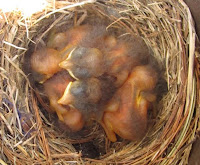 |
| Recently hatched bluebirds. |
The cool weather in the past two weeks hasn’t stopped the
bluebirds, chickadees, and tree swallows from progressing with their nesting
activities at Como Park
 |
| A nest full of chickadees, over a week old. |
Tuesday, May 16, 2017
Como Park Bluebird Trail Update: May 15, 2017
Post contributed by Sharon, volunteer bluebird trail monitor:
Nesting
season is well underway this week—things can happen fast once they get going.
Now there are 20 bluebird eggs in four nest boxes, six chickadee eggs in one
box, and four tree swallow nests built. Two other boxes have some nesting
materials inside but not enough to identify the creators.
 |
| Bluebirds usually lay between 3-5 blue eggs,but for the last few years we've had a pair that lays 6 or 7 pale white eggs. |
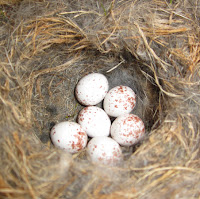 |
| Chickadee eggs are smaller and speckled. |
Thursday, May 4, 2017
Como Park Bluebird Trail Update: May 2, 2017
Post contributed by Sharon, volunteer bluebird trail monitor:
On the trail today there are two bluebird nests, one with three eggs and the other with one. Tree swallows seem interested in several boxes, but haven’t yet started building any nests. Chickadees started a nest in one box, but may have been stopped from finishing it by tree swallows, even though last week I installed a chickadee entrance hole guard (at 1-1/4” the opening is too small for other birds like tree swallows). Things are off to a slow start this year.
 |
| The first bluebird eggs of the season. |
On the trail today there are two bluebird nests, one with three eggs and the other with one. Tree swallows seem interested in several boxes, but haven’t yet started building any nests. Chickadees started a nest in one box, but may have been stopped from finishing it by tree swallows, even though last week I installed a chickadee entrance hole guard (at 1-1/4” the opening is too small for other birds like tree swallows). Things are off to a slow start this year.
Como Park Bluebird Trail Update: April 17, 2017
Post contributed by Sharon, volunteer bluebird trail monitor:
No nests yet. Some years nest building begins earlier than others. In
the past few years, the first nesting activities began as early as April 8 and
as late as May 5. No doubt the bluebirds know what they are doing. Signs of
spring are everywhere, and I heard squabbling bluebirds in two areas of the
park.
Monday, April 3, 2017
Como Park Bluebird Trail Update: April 3, 2017
All 11 Como Park Bluebird Trail nest boxes have been up since March 22 and are awaiting occupants. No nesting activity yet, but a bluebird was singing softly in the Como Woodland Outdoor Classroom, where three of the boxes are located. Bluebirds and chickadees will start building their nests soon, and tree swallows will arrive a little later.
Monday, January 9, 2017
Restoring the Floodplain
Post contributed by Brett Stolpestad and Brad Chatfield, Conservation Corps of Minnesota:
 |
| Great Horned Owls are one of the many species that use Saint Paul's floodplain parks to raise their young. |
The Mississippi River floodplain is Minnesota’s centerpiece. A
patchwork of cottonwood, maple, boxelder, hackberry, and ash make up the
forest ecosystem, providing critical habitat for migratory birds and other river-dependent wildlife. The
City of Saint Paul is home to a beautiful winding chain of parks along the
Mississippi and uses a variety of management practices to augment the health of
the floodplain ecosystem. One particularly useful and beneficial technique is shelterwood harvesting, the process of gradually removing mature
trees in a given area with the goal of establishing the next generation of
desirable tree species. This process has the potential to increase
biodiversity, improve wildlife habitat, and eliminate invasive species.
How does
shelterwood harvesting work?
Step one: Land managers begin by surveying
forest transects using satellite images, GPS units, and GIS software. At this
stage, typically called a forest composition survey, surveyors attempt to create
a map that clearly illustrates the distribution of tree species, the total
canopy cover, the average size of the trees and perhaps their age.
Step two: Surveyors identify potential
shelterwood harvest sites by analyzing sections of forest that may lack
diversity or contain undesirable species like buckthorn, white mulberry, or Siberian elm.
Step three: Through several gradual stages, foresters
begin removing trees that lie within the designated shelterwood harvest area. Removing
these trees helps to open the canopy, allowing sunlight to reach the forest
floor where the next generation of saplings can become established.
Step four: Native tree species can then be
planted in the newly created pockets, adding to the biodiversity of the
ecosystem and improving wildlife habitat. Trees or shrubs such as cottonwood,
silver maple, sugar maple, black willow, elderberry, and red osier dogwood
might be selected!
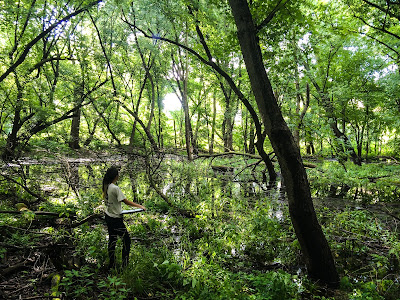 |
| A Conservation Corps member completing a canopy survey at Hidden Falls Regional Park. |
In recent
years, prominent Saint Paul Parks including Hiddens Falls, Lilydale, and Crosby Farm Regional Parks have all been selected
as sites for shelterwood harvest. The decision to focus on these parks has
been, in part, a response to ecological threats including the encroachment of emerald ash borer. The threat of emerald ash borer has
led to the preemptive removal of ash tree throughout the floodplain, followed
by several large-scale volunteer planting events. Over the past few years,
volunteers have helped plant hundreds of trees and shrubs throughout Crosby,
Lilydale, and Hidden Falls. If you visit these parks today, you will
undoubtedly see dozens of young maple, cottonwood, and black willow standing
straight in their “tree-tubes,” along with an understory smattering of black
willow, dogwood, and elderberry.
 |
| Shelterwood harvest areas are replanted with native tree species. These young trees are protected with tree tubes, which facilitate growth and protect the saplings from hungry animals. |
The
Mississippi River floodplain remains a gorgeous and dynamic landscape in the
heart of our state. The floodplain parks of the Twin Cities offer the
opportunity for city-dwellers to walk the long winding paths through towering floodplain
giants, and to become immersed in the wildlife sanctuary that the floodplain provides.
Tuesday, January 3, 2017
Lake Como Restoration
Post contributed by Liam Krause and Dennis Walsh, Conservation Corps of Minnesota:
Who doesn’t enjoy a refreshing jaunt around Como Lake? With almost two miles of walking and biking
paths, paddleboats available for rent, and refreshments waiting at Como
Dockside, there is something to do for everyone. For over 100 years, Como Lake’s proximity to
Saint Paul has been a welcome respite for from urban life for residents, but
Como's proximity to the city is beginning to take a toll on the health of our
lake.
The Problem
Have you ever noticed
the greenish hue on Como Lake during the summer months? That coloration is
indicative of a process called nutrient loading. This phenomenon occurs when
too much of one or more nutrients makes its way into a body of water. This can
happen when runoff draws sediment off the roads or fertilizers off our lawns as
it drains into a lake, pond, or river. When a body of water takes in excessive
nutrients, it promotes disproportionate algae growth. The algae soon dies,
leaving decaying organic matter. The decomposition process consumes dissolved
oxygen in the water, oxygen that other living things in the lake depend on.
This could potentially create a "dead zone." This is happening to
Como Lake. For a more detailed outline of contributing factors and findings
specific to Como Lake, visit the report published by the Capitol Region Watershed District (CRWD).
What We've Done
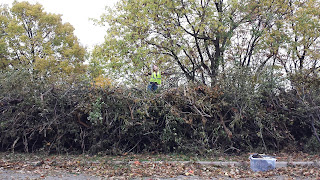 |
| Huge brush pile of invasive species created by volunteers. |
With the help of a CRWD cost-share grant program, and the
efforts of the Conservation Corps of Minnesota and Iowa, the City of Saint Paul
has taken big steps in reducing the sedimentation and runoff going directly
into our lake. The North Lake Como Restoration project has targeted 4.25 acres
of disturbed land in order to enhance and restore important oak savanna and
woodland habitats. When completed, the changes to the target areas will help
recharge groundwater, improve the water quality of the lake, and provide a diverse
environment for wildlife.
First, the target areas were swept for
invasive species such as buckthorn, black locust, mulberry, and
honeysuckle. These species disrupt natural biodiversity and choke out
herbaceous ground cover, which can result in increased erosion. Thanks to the
hard work of volunteers, all of the cut material was hauled offsite. The site
was then prepared for seeding. Along East Como Lake Drive, all of the leaf
litter was removed in preparation for a process called hydromulching. Hydromulching
is the application of seed and mulch to reestablish vegetation, often used to
control erosion and retain soil moisture. A cover crop, and a native grass seed
mix was broadcast throughout the project area and erosion control materials
have been laid. With any luck, Saint Paul residents will start to see healthy
shoots of little bluestem, canada wild rye, and indian grass popping up as they
walk around Como Lake this spring.
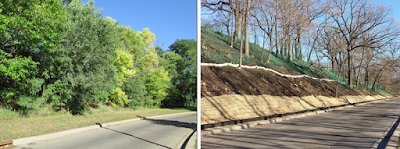 |
| East Como Lake Drive before invasive species removal and hydromulching (left) and after (right). |
What You Can Do
Nutrient loading is the effect of too much moving from our lawns to our lakes. In order to counteract the process, it will take the sustained combined effort of everyone in the area to restore Como Lake to a healthy state. Some of the things you can do to help are limiting the use of lawn fertilizer, install buffer strips or rain gardens, and keep your eye out for volunteer events with the City of Saint Paul. If you are interested in making greater changes to combat the effects of nutrient loading, the Minnesota Pollution Control Agency has a list of steps you can take. Together we can protect this popular Saint Paul destination.
Subscribe to:
Posts (Atom)



